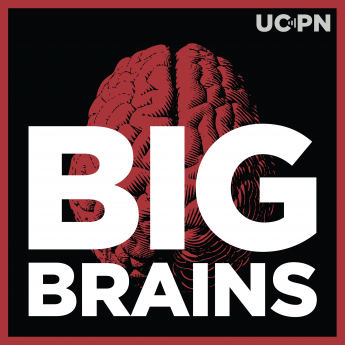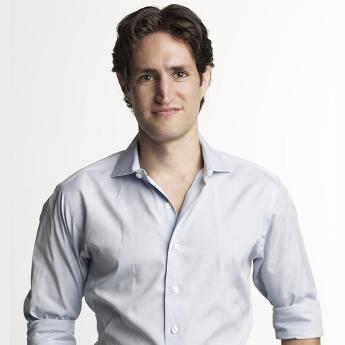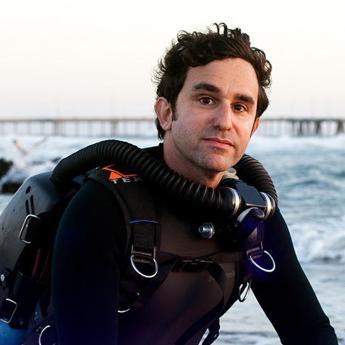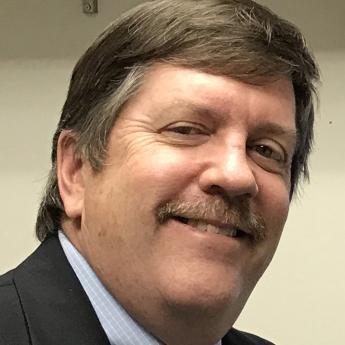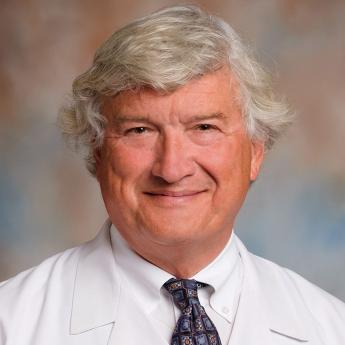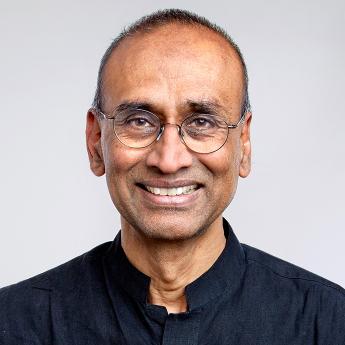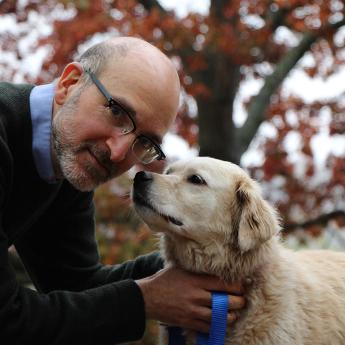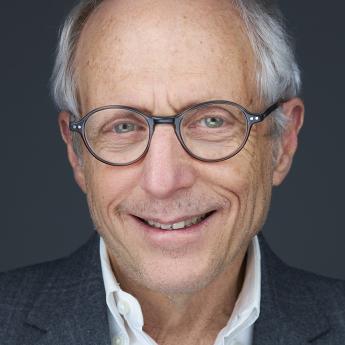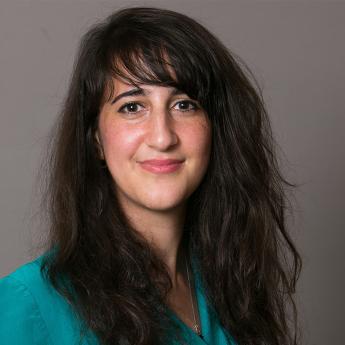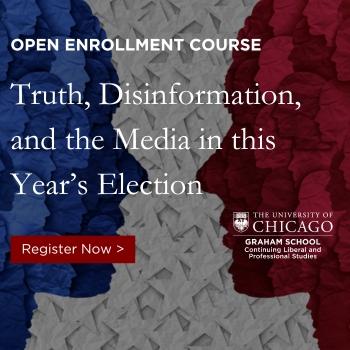Show Notes
Why is it so hard for us to form good habits—and so easy to form bad ones? Most people turn to the self-help section to find answers, but this is really a question for behavior science.
Katy Milkman is a professor at The Wharton School of Business at the University of Pennsylvania and co-directs the Behavior Change For Good Initiative with Angela Duckworth. Her best-selling book, How To Change: The Science of Getting From Where You Are To Where You Want To Be, explores that best research—from “nudges” to “temptation bundles”—on how to change our behaviors and habits for good.
Subscribe to Big Brains on Apple Podcasts, Stitcher and Spotify.
(Episode published September 9, 2021)
Related:
- How to Change: The Science of Getting from Where You Are to Where You Want to Be—Claremont McKenna College
- What are the best approaches to engage the vaccine-hesitant now?—Quartz
- What are the biggest barriers to behavior change?—Chicago Booth Review
- How to Actually Change Your Behavior for the Better—GQ
- Video: Think Better with Katy Milkman—Chicago Booth
Transcript:
Paul Rand: Why is it so hard to change our habits? What makes it easy for one person to eat well and exercise, but so hard for another? People often look for answers in the self-help section, but these are all questions for behavioral science.
Katy Milkman: Behavioral science is the study of the way people make decisions and the way they form judgments, and it tends to blend psychology and economics.
Paul Rand: This is Katy Milkman. She’s a professor at the Wharton School at the University of Pennsylvania, and she recently gave a lecture at the University of Chicago about her new book, How to Change: The Science of Getting From Where You Are to Where You Want to Be.
Katy Milkman: The lens is really grounded in some of the basic tenants of economic theory, which say people are rational decision makers and can weigh costs and benefits and come up with the right calculus to make their choices. What behavioral science adds to that mix is really a recognition that people sometimes make mistakes and that this can happen in systematic and predictable ways, and once we understand that, we can help people make better decisions.
Paul Rand: Katy is full of tips and tricks based in science to help us create lasting behavioral change. For example, the Mary Poppins principle.
Mary Poppins: In every job that must be done, there is an element of fun. You find the fun and, snap, the job’s a game.
Katy Milkman: Mary Poppins, wonderful children’s movie, has a great and very famous line, which is ...
Mary Poppins: (singing).
Katy Milkman: If we can find a way to make something fun by adding a spoonful of sugar, it will be more likely that we take our medicine.
Paul Rand: For many vaccinated people, it feels a little bit like new years. We’re thinking of how we want to change and grow. Milkman’s research is a perfect place to go to understand how.
Katy Milkman: So many people have been reflecting on what they want to do differently in this new moment. It has caused a lot of big picture thinking.
Paul Rand: From the University of Chicago Podcast Network, this is Big Brains, a show about the pioneering research and pivotal breakthroughs that are reshaping our world. This episode, what science has to say about changing our ways and achieving our goals. I’m your host, Paul Rand.
Paul Rand: Katy Milkman may be your professor at the University of Pennsylvania, but she has close ties to many scholars here at the University of Chicago.
Katy Milkman: One in particular I have to mention is Nobel Laureate Richard Thaler, whose work on nudging and choice architecture have frankly shaped my worldview.
Speaker 4: Nudging is done by what we call a choice architect, which is a fancy term for anyone who influences the choices that you make. Take the example of the cafeteria downstairs, somebody had to decide where to put the salad bar, where to put the burgers. For example, in our cafeteria, you have to go by the salad bar to get to the burgers. That increases the chance that you’re going to go for the salad, you’ve been nudged.
Katy Milkman: Once we understand people’s limitations, we can use those insights as a tool for helping them make better decisions. We can restructure environments with our knowledge of people’s limitations to try to help them make better choices. That’s really foundational to the work that I’ve been doing in my career.
Paul Rand: Much of that work is done at her research lab called the Behavior Change for Good Initiative.
Katy Milkman: We have about 150 scientists from different disciplines who are part of a team that we organize at the Behavior Change for Good Initiative. We call the kinds of studies that we do mega studies, they’re-
Paul Rand: Mega?
Katy Milkman: Mega, exactly.
Paul Rand: Okay, wow. That’s big.
Katy Milkman: You got it, you got it. That was the idea, the branding is working. We run massive experiments trying to test interventions built on behavioral science, designed to improve policy-relevant behaviors for good, both for better and durably. Instead of one study at a time, one mega study at a time.
Paul Rand: Milkman has worked with, or advised, dozens of organizations, like the Red Cross, Google, and recently, the Biden administration, which she advised on vaccine distribution. In April, she and her colleagues published a study on flu vaccines they’d ended up applying to COVID-19.
Katy Milkman: When I say a mega study, what’s different about the way we’re doing science than the way science is normally done, instead of running a single study that will test a single hypothesis, we actually go to our team of 150 scientists and we say, ‘‘We want to know how to encourage vaccination. This is really important for a number of reasons. We don’t know enough about it. We are going to have a chance to run a test with all of Walmart’s pharmacy customers who have gotten a vaccine in the past and signed up for text messages, so about 700,000 people. We can communicate with them in any way you can dream up to try to encourage them to come get a vaccine. What should we say?ְ’’
Katy Milkman: Dozens of people submit their best ideas, and we developed, in this particular case, a mega study, where we tested not one or two ideas that might change behavior for good, but over 20 ideas, all simultaneously with the same outcome variable, the same population. We can say, ‘‘Okay, we can make apples-to-apples comparisons about what’s working best, what’s most cost-effective.’’ In this case, by the way, we were studying this with flu vaccines, the hope of porting it into change behavior around COVID-19 vaccination. We also studied this with two local health systems and studied messages sent before a doctor’s appointment to encourage people to get a vaccine when they went to the doctor. In all three settings where we tested it, the best performing message was a really simple message that said, ‘‘We’ve reserved a vaccine for you, come and get it.’’
Paul Rand: Ah, okay.
Katy Milkman: We tested other things like telling you a joke so maybe it would be more memorable, we tested telling you do it to protect friends and family and loved ones.
Paul Rand: How many people suggested turning off Tucker Carlson?
Katy Milkman: Sadly, that is not an intervention that can be delivered by your pharmacy as far as I know.
Paul Rand: Okay.
Katy Milkman: We tested all sorts of messages, but the message that said a vaccine is reserved for you or waiting for you, we think one of the reasons it may have been so effective is that there’s something called the endowment effect, which Richard Thaler of UChicago has studied. We value things more when they believe they belong to us, we don’t want to give them up, that feels like a loss, so there’s probably a little of the endowment effect going on there, ‘‘Oh, it’s mine. I don’t want to give that away.’’ It probably makes it seem like it’s going to be less of a hassle. ‘‘You reserved this vaccine for me, it’s going to be waiting for me. That’s no problem, I’ll come and get it.’’ It also probably conveys a recommendation. ‘‘Why would you have reserved this for me if you didn’t suggest that I get it, if you didn’t think it was the right thing to do? My pharmacist or my doctor must be telling me this is a recommendation.’’
Katy Milkman: We’ve looked at ways that we can increase exercise durably, we’re in the process of studying interventions to improve savings outcomes as well as educational outcomes.
Paul Rand: If we talk specifically about your book, How to Change: The Science of Getting From Where You Are to Where You Want to Be, it has a bit of a sense of self-help to it, like if I walked into Barnes and Noble, I would see that there, but there’s a difference that I’ve read you’ve talked about. Can you help explain that a little bit?
Katy Milkman: Yeah. This was really a difficult thing to think about, by the way, I should say a lot of time went into thinking about the title and the subtitle and how do we convey this is a book about science. I think a traditional self-help book has a point of view that’s very strong, often with a few prescriptions. Generally, they’re not grounded in science. One of the things that I have found, that’s the central argument of the book, is the reader needs to become quite sophisticated about the science on the barriers that keep us from achieving our goals, so that they’ll be equipped to figure out, well, which are the ones that are holding me back and how exactly could I use the best tactics from science in a wise way to get the outcome I’m looking for.
Paul Rand: Which brings us to one of our first scientific concepts, present bias.
Katy Milkman: We focus too much on the here and now, whatever value we’ll get right now, well, this tastes good, and a lot less than would be optimal on all the long-term benefits we’ll achieve. Another UChicago professor has done some of the best research on this topic, Ayelet Fishbach, showing that we under-appreciate this present bias. We think if we just set a big goal and we go for it, we’ll be able to do the thing that’s good for us.
Paul Rand: Well, you had a paper that you did at some point about DVD rentals, is that right?
Katy Milkman: Yeah, absolutely. This was part of my dissertation, and I do have to say, I feel like a dinosaur when I teach this to my Wharton MBA student, because I have to-
Paul Rand: What’s a DVD?
Katy Milkman: Exactly. I have to explain to them this concept of this company called Netflix, that used to mail you DVDs. You’d pick them in a certain order, they’d show up at your house in that order. Because there was a time delay between the point when you made your selections and the moment when you got to actually take action, people, when they were ordering in advance, would think, ‘‘I’m going to watch highbrow movies. I want to become educated and enriched.’’ Then when the movies arrived, they would think, ‘‘Actually, that sounds great for tomorrow, but today I’m just going to pop in this lowbrow action flick.’’ Just as we take on too much credit card debt because we like to buy shiny baubles and don’t save enough for retirement, present bias also afflicts us when it comes to the entertainment choices we make, when it comes to the food choices we make. How do we counter that?
Paul Rand: One of the ways we can push back against our own bias toward the present is something Katy calls temptation bundling.
Katy Milkman: Yeah, absolutely. This is an idea that I studied based on my own life experience, so I would call it me-search.
Paul Rand: Me-search, I saw that. I like that.
Katy Milkman: Rather than research.
Paul Rand: Yeah.
Katy Milkman: The me-search started when I was a graduate student and I was struggling at the end of a long day to motivate myself to go to the gym. I knew I should, but really all I wanted to do was binge watch some TV.
Paul Rand: Something highbrow, of course.
Katy Milkman: No, lowbrow, all I wanted was lowbrow.
Paul Rand: Okay.
Katy Milkman: Absolutely lowbrow, Yeah. I wasn’t renting Netflix documentaries for next week. I was putting something on immediately. I did it with audiobooks. I found it was too much sensory input for me to run and watch movies. What I realized is maybe I could solve all of these problems in one fell swoop with what I now call temptation bundling. I created a rule. I said, ‘‘I’m only going to let myself enjoy this indulgent entertainment when I’m at the gym exercising.’’ What happened was almost like magic. I started coming home craving trips to the gym to find out what would happen next.
Katy Milkman: I’ve now studied this. We’ve run two experiments showing, in different settings, that giving people the insight to temptation bundle and giving them a free audiobook can increase their exercise, and in another study we showed that actually literally locking tempting audio novels a the gym so people could only access them when exercising increased exercise.
Paul Rand: There’s another story that you talked about in the book about the Swedish subway station, which I also thought was quite interesting. It kind of falls into the same camp here, doesn’t it?
Katy Milkman: Yeah, it absolutely does. This is one of my favorite videos to show when I’m teaching. It’s a video of a little experiment that was run by some marketers in a Swedish subway station, where they were trying to get people to take the stairs instead of the escalator, because it’s good for you, and most people-
Paul Rand: Get steps in.
Katy Milkman: Yeah, get those extra steps. Most people though choose the escalator and it’s crowded and it’s not as good for them. What they came up with is a way to make the stairs fun. They turned them into piano keys so that as you walked up the stairs, they would play music. What they found is that in turning the stairs into an object of pleasure, a joy, a treat, a toy, they increased the number of people taking them by about 66% in the short term. I like to highlight my recommendation for the obesity crisis is not that we simply lay down piano stairs everywhere. It’s just a cute illustration of this overlooked idea that when we make something more fun and instantly gratifying, it’s much more likely we’ll choose it.
Paul Rand: Another one of Katy’s innovative ideas centers around what she calls the fresh start effect. She’s found that the story we tell ourselves about our own lives is a crucial piece to creating behavior change.
Katy Milkman: When we think about our lives, we think about ourselves as if we’re characters in a book and we think of our lives in chapters. Where the chapter breaks fall turns out to be really important to where we feel like we have a new beginning or a fresh start. The start of a new year, right, we know about New Year’s resolutions.
Paul Rand: Mm-hmm (affirmative), of course.
Katy Milkman: The start of a new week, the celebration of a birthday, the start of a new month. What we found is that people naturally gravitate towards these moments that have new beginning flavor to make changes in their lives, they’re more likely to search for the term diet on Google to visit the gym. What we think is going on, and what the research points to, is that that sense of a chapter break, that sense of a fresh start gives you a feeling that you’re turning a new page and the old you is further away. You feel like there’s an identity break.
Katy Milkman: But let me tell you about one of my favorite studies where we actually show that you can nudge people to change their behavior more effectively at these moments. We partnered with four employers that were trying to get their employees to save more for retirement and contacted about 2000 people who were either not saving it all for retirement or saving an extremely low level. We sent them mailings with a postcard where they could check a box and sign their name and sign up to start saving, so they’d start having a portion of every paycheck deducted and sent to a retirement account that’s tax advantaged.
Paul Rand: Okay.
Katy Milkman: What we did, using the fresh start effect, is we thought, look, a lot of people aren’t going to be willing to start saving right away. They’ll prefer to do it perhaps at a time delay. What if we aligned the time delay offered with a fresh start moment, like their birthday or maybe the start of spring? Say you have two people, they both have a birthday coming up in two months, we’d flip a coin, one of them gets a mailing inviting them to start saving in two months, the other gets a mailing inviting them to start saving after their upcoming birthday. Now, note they’re literally the same offering, but in one case we’re bringing attention to the fact that it aligns with a fresh start date. What we found is that when we highlighted an opportunity to begin saving after a birthday or aligned it with the start of spring and said, ‘‘Do you want to start saving at the start of spring,’’ over the next eight months, we saw a 20 to 30% increase in total savings.
Paul Rand: Wow, remarkable.
Katy Milkman: People were more attracted to beginning their savings goals, beginning to pursue their savings goals, when the start date aligned with one of these fresh start moments.
Katy Milkman: I also think that the use of fresh starts is going to be most valuable in settings though where we can do things once that have really big long-term consequences. Choosing to sign up for a savings program and you’re going to have money auto-deducted is just one moment when you’re feeling that extra motivation that can carry you a long way. If we had, say, tried to encourage you to sign up to get weekly emails about how to live a healthier life, I’m not sure that would’ve had any benefit. We might’ve gotten you to sign up, but would you have still been motivated by the time you got your second email to do anything about it?
Paul Rand: After the break, how the fresh start effect can backfire and why Katy Milkman focuses on creating behavior change for the longterm, or as she says, for good.
Paul Rand: Hello, Big Brains listeners. The University of Chicago Podcast Network is excited to announce the launch of a new show. It’s called Entitled, and it’s about human rights. Co-hosted by lawyers and UChicago Law School professors, Claudia Flores and Tom Ginsburg, Entitled explores the stories around why rights matter and what’s the matter with rights.
Paul Rand: We are all starting programs, hopefully we keep with them but oftentimes we start off with what are these best intentions, we do a fresh start, whatever the case is, but sometimes we get to that end of that rope and we don’t pick it up or go on. Why is that? Where is it that we get off track? What other reasons to people actually give up on something they were so committed to?
Katy Milkman: One reason is called the what the hell effect. You’re trying to stick to a reasonable diet and somebody brings in donuts to work in the morning and you have one because they’re delicious and tempting and they’re right in front of you and how can you resist, and then you say, ‘‘What the hell, I might as well have pizza for lunch, and for dinner, we’re going to go to the steakhouse and we’ll get the cheesecake for dessert.’’ Once you’ve had that small failure, you feel like the whole thing is silly and you should give up.
Paul Rand: I see.
Katy Milkman: That’s one of the problems. Another is really related to the fresh start effect, it’s sort of the ugly of it, which is they can actually be harmful when you’re on a roll. Something that disrupts a successful ... You’re feeling like, ‘‘I’ve got this, my things are going beautifully,’’ and then a fresh start intervenes. It’s a new year, a new week, and all of that progress may feel like, ‘‘Well, that was the old me and the new me now has to start all over again and that’s going to be a really heavy lift.’’ Anything that disrupts our momentum, unfortunately, is really harmful because a lot of habits are fairly brittle. It’s easier to fall back on the things that give us instant gratification. The path of least resistance, unfortunately, that is our default mode.
Paul Rand: One of Katy’s ideas to work against the obstacle of the what the hell effect is called a commitment device.
Katy Milkman: A commitment device is something that is very counterintuitive to a lot of people, and particularly economists, because we’re used to other people incentivizing us to change our behavior, if you give into the temptation to speed, you’ll get a fine, but a commitment device actually is when you do that to yourself. You create a fine or some sort of incentive contract or some sort of restriction that will prevent you and your future self from giving into a temptation.
Katy Milkman: One of my favorite studies on this as a study that is done by Nava Ashraf, Dean Karlan and Wesley Yin, in partnership with Green Bank in the Philippines. The idea was to try to help people save more by giving them a commitment device that would restrict their access to their money so they’d be able to resist the temptation to dip into savings whenever there was an exciting trinket they wanted to buy or a special occasion. They gave two populations access to standard savings accounts with a standard interest rate, randomly assigned let’s say 500 people each group, everybody has a standard savings account on offer. One of those two groups, but based on a coin flip, also was invited to put money, if they preferred, in a commitment account. This is an account with exactly the same interest rate as a standard account, but in this account, you can’t take your money out until you’ve reached a predetermined date you choose or a goal that you set for yourself.
Katy Milkman: A standard economic model would say, ‘‘This is insane. No one would ever want that. You’re trading off liquidity and you’re getting no interest rate in return. The interest rate is the same so this is strictly worse,’’ but what the researchers found is that about 30% of people wanted that account and said, ‘‘Ooh, I’m going to put some money in there. That looks great.’’ When they did this random assignment study, half of people had access to that account and half didn’t, what they found is overall the people with access to the account saw an 80% increase in their savings year over year, just because they had a way to restrict their impulses to spend.
Paul Rand: Commitment. devices use a rigid outcome to keep us on track, but for certain kinds of habit forming too much rigidity can be a problem. In one of Katy’s most surprising experiments, she broke people into two groups, which she dubbed Routine Rachels and Flexible Fernandos.
Katy Milkman: The experiment we ran was a month-long program where we encouraged Google employees either to go to the gym at the same time of day every day that they went, or we provided encouragement for flexibility. We did this with incentives of various sizes and types for a month, who is going to have a more lasting habit when we set a stop holding their hand and rewarding them? We let go, nobody’s getting incentives or the same kind of encouragement, who has a more lasting habit? Is that the person who’s been going consistently, the Routine Rachel, or is it the person who’s going on a more flexible schedule, the Flexible Fernando? Those are the names.
Katy Milkman: What surprised us is that we found it was the Flexible Fernando, not the person who had that consistency, but the person who had more flexibility. The key reason was that the people who had built these really consistent routines had built brittle routines. Say you’re a 7:00 AM exerciser, what we found is they go a little bit more at 7:00 AM after that month, but if they don’t make their 7:00 AM regular workout, they don’t go at all.
Paul Rand: That or nothing.
Katy Milkman: Right. They built an all-or-nothing routine. The Flexible Fernando who sometimes goes at 7:00 AM, sometimes goes at noon, he maybe goes a little bit less at 7:00 AM, but if he misses 7:00 AM, he still goes at noon or at 5:00 PM. He’s built a no-matter-what routine, a more flexible routine. It’s more robust to all of the curve balls that life throws us. What I think is interesting is we really did not expect this. We really believed, based on the habit literature, that the best thing to do is to build really consistent routines. We were so surprised and intrigued to discover the importance of building that more flexible kind of habit in order to create robustness.
Paul Rand: Okay. Now, that this idea of, like you said, not wanting to break commitments to ourselves fits a little bit into this idea that some of your studies talked about, our beliefs and our expectations make a real difference, and if our belief is that we honor our commitments or those are expectations. Give a little more context, if you would, of what beliefs and expectations mean when it comes to creating change.
Katy Milkman: Yeah. This I think of is really important when the barrier to change is self-confidence, which isn’t always the barrier of change. Some of us, in fact, a lot of us, are overconfident about our ability to change and that could be a barrier, but sometimes a reason someone is not pursuing a goal or achieving a goal is they just don’t believe that they can do it and so why would I put in the effort, why would I invest if I think this is a hopeless goal? When that’s the barrier, then there are different tactics that we’re going to want to use in order to encourage change.
Paul Rand: Katy says that one of the ways we can help people who are struggling with self-confidence is by actually putting them in the role of mentor. She first studied this and students, asking them questions like, ‘‘How would you avoid procrastinating?’’ and, ‘‘Can you write a note to another student who’s struggling to do better in school?’’ She found that this simple exercise raised the kids’ grades and helped with motivation. Then she tried it in a group of people trying to quit smoking and found that it actually worked there too.
Katy Milkman: The real insight at the core of this work is that often when somebody is struggling to achieve a goal, it’s not because they don’t have any insights about how to do it. Often, it’s a confidence issue. One way we can boost people’s confidence is actually by putting them in the role of advice-giver. If I say, ‘‘I think you know more than you realize about this and I want you to coach someone else on how to achieve it,’’ suddenly they can feel proud and maybe I do have what it takes if you think I’m good enough to coach someone else. Another thing that is a benefit of putting someone in the role of a coach is that they’re going to have to give advice to someone else, they’ll have to dredge up some useful insights and then they’re going to feel hypocritical if they don’t take that advice themselves.
Paul Rand: As we talked about behavior change as a whole, you mentioned that, and I think it fits into what you were just talking about, but it’s more like treating a chronic disease than curing a rash, which is some ways a little unfortunate because you can treat the rash and Hopefully it doesn’t come back, but chronic disease means I’ve got to keep working on it, doesn’t it?
Katy Milkman: It does. It’s funny, I really think that’s a useful point, and yet I wish that there were a more elegant way to make it, but hopefully it captures the imagination. It’s sticky.
Paul Rand: It does, yep.
Katy Milkman: It’s sticky, even though it’s a little off-putting. But the challenge, I think, about behavior change though is that so often we want a quick fix, we want a one-time solution that will carry us forward. All of the barriers to change that I’ve studied, that others have studied, they aren’t the kinds of things that you can cure. It’s not like you can say, ‘‘Oh, now I understand that present bias and impulsivity are a thing. I’m just going to get rid of that for myself.’’ No, we’ll always gravitate towards things that are instantly gratifying and under-appreciate the things that will give us longterm value. If we have issues with self-confidence, those are likely to persist. If we have habits that get in the way or a tendency to take the path of least resistance and that can prevent us from achieving our goals, it’s not going anywhere.
Katy Milkman: We can use tactics to try to outsmart these challenges, but they can’t be applied once, they really need to be used continuously because the barrier is not disappearing. For instance, if you figure out that temptation bundling helps you get yourself to the gym, it’s not like you could just go to the gym for a month by only watching your favorite TV show and now suddenly the gym will become a pleasure and you don’t need to do that anymore. The gym will probably still not be fun for you if it wasn’t fun before, if you take away the bundle. You’re going to need to keep on giving yourself the hook to make that chore into a pleasure.
Paul Rand: Okay.
Katy Milkman: That’s kind of the key idea, is that we shouldn’t be looking for a silver bullet that’s a one and done, but rather recognizing whatever it is that we need, whatever hacks we need to use to overcome the barriers to change, they’re going to be perpetual rather than short-term.
Episode List
Feeling stuck? Here’s how to achieve a breakthrough, with Adam Alter (Ep. 139)
Scholar shares research on the tools to help overcome difficulties—from a job to a relationship
What makes something memorable (or forgettable?) with Wilma Bainbridge (Ep. 138)
Psychologist discusses the Mandela effect and a new AI tool to predict what we remember—from art to people’s faces
Learning to speak to whales using AI, with David Gruber (Ep. 137)
Scientist discusses how Project CETI is deciphering the Morse code-like ‘alphabet’ of sperm whales
Storm warning: Why hurricanes are growing beyond measure, with Michael Wehner (Ep. 136)
Scientist proposes a new Category 6 for hurricanes, calculates the growing cost and impact of climate change
How to manifest your future using neuroscience, with James Doty (Ep. 135)
‘Mind Magic’ author explains the scientific research on how to train our brain to achieve our goals
Why we die—and how we can live longer, with Nobel laureate Venki Ramakrishnan (Ep. 134)
Nobel Prize-winning scientist explains how our quest to slow aging is becoming a reality
What dogs are teaching us about aging, with Daniel Promislow (Ep. 133)
World’s largest study of dogs finds clues in exercise, diet and loneliness
Where has Alzheimer’s research gone wrong? with Karl Herrup (Ep. 132)
Neurobiologist claims the leading definition of the disease may be flawed—and why we need to fix it to find a cure
Why breeding millions of mosquitoes could help save lives, with Scott O’Neill (Ep. 131)
Nonprofit's innovative approach uses the bacteria Wolbachia to combat mosquito-borne diseases
Why shaming other countries often backfires, with Rochelle Terman (Ep. 130)
Scholar examines the geopolitical impacts of confronting human rights violations

